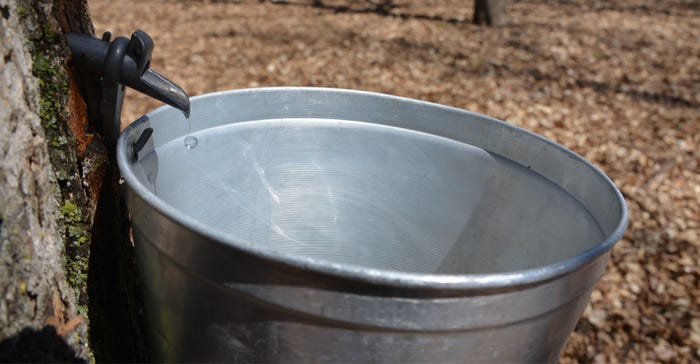February 5, 2021

Spring is a time of year many people look forward to. It is also the time when the sap of Wisconsin’s state tree, the sugar maple, begins to run. The sap run signifies the crossroads of winter moving out and the welcoming of longer and warmer days ahead.
Spring is when Wisconsin’s first crop of the new season is harvested. With this annual spring tradition, it is the perfect time for all of us to indulge in pure maple syrup and savor the many benefits that this liquid gold brings to the state.
Tree tapping
My first experience with maple syrup, beyond waffles and pancakes, was in my local 4-H club when I was only a Clover Bud (7 years old.) Our Clover Bud group tapped trees in the woods near our group leader’s home. We learned how to identify maple trees and what makes a tree perfect for tapping.
We tapped the trees by drilling holes, placing spigots and hanging buckets. It was a contest to see which tree had the most sap. I helped my friend pick the winning tree. After the trees had been tapped, we made pancakes and topped them with sweet homemade maple syrup.
Maple syrup season has a rich history in Wisconsin. Our state ranks fourth in the nation for maple syrup production, behind Vermont, New York and Maine.
The higher the yield of sap and the sweeter the sap usually means higher yields of maple syrup. Sugar-makers follow the Jones’ Rule of 86, devised in 1946 by C.H. Jones, a scientist and educator at the University of Vermont, which estimates the volume of sap needed to make 1 gallon of syrup. If the sap concentration of sugar is at 1%, then 86 gallons of sap are needed to make 1 gallon of syrup. As maple sap sugar concentrations are typically at 2%, about 40 gallons of sap are needed to produce 1 gallon of syrup.

To make pure maple syrup, farmers tap maple trees to harvest the sap found within. Interestingly, this practice is only done on a commercial scale in North America. The sap best flows out of the maple tree when the night gets below freezing and the day is warmer than 32 degrees F. This means the trees are typically tapped during the early spring, sometime between February and March. Sap will then flow from the tapped trees for anywhere from 20 to 30 days, depending on the weather.
Once the tree is tapped, two different types of systems can be used to collect the sap. The first is a gravity system. As its name implies, it uses gravity to drip the sap from the tree into a pail. Alternatively, farmers can use a vacuum collection system, which pulls the sap from the tree into a bucket. The amount of sap collected increases when a vacuum system is used compared to a gravity drip. In a single tapping season, one tree can yield more than 10 gallons of sap.
Grading scale
When this syrup hits local store shelves, you’ll notice the variety of different grades available. This grade doesn’t necessarily indicate quality, but instead indicates coloring and flavor. The grading scale is largely based on translucence, which measures how much light passes through the syrup. As a rule of thumb, lighter variations of syrup are produced early in the season during the coldest temperatures and darker syrups are produced late in the season when temperatures rise. The darker the syrup color, the more intense the maple flavor will be.
Grade A syrup is comprised of three subcategories: light amber, medium amber and dark amber. Light amber is known for its smooth, delicate flavor and is primarily used in maple candies and creams. Medium amber has a subtle maple flavor and is most often used for table syrup, as is dark amber, which can also be used for sweetening purposes in recipes and glazes and atop pancakes or oatmeal.
Grade B syrup is produced late in the season and is characterized by a dark color and strong flavor, as the sugar content of the sap has dropped and more sap is required to produce a gallon of syrup.
Commercial-grade syrup rounds out the grading scale as the darkest and strongest-flavored. This type of syrup is popular among food manufacturers for its intense flavor for use in maple-flavored foods.
One way to use maple syrup, other than for breakfast, is to make candy. There are many different recipes. Hard or softer candy can be made by boiling syrup. A candy thermometer is recommended to reach the exact temperature, and that affects the hardness of the candy. If you want to add some crunch, throw in your favorite nuts, or sweeten the deal even further and top with chocolate.
Pure maple syrup contains no preservatives, colorings or additives and has one of the lowest calorie levels. Absolutely nothing is added to real maple syrup, as water is simply evaporated from the sap to yield pure syrup.
Think beyond pancakes and waffles when it comes to this sweet treat. To add natural sweetness to your next baking recipe, salad or even meat roast, try incorporating Wisconsin maple syrup. For more details on this sweet industry, visit wismaple.org.
Nunes is the 73rd Alice in Dairyland.
You May Also Like




